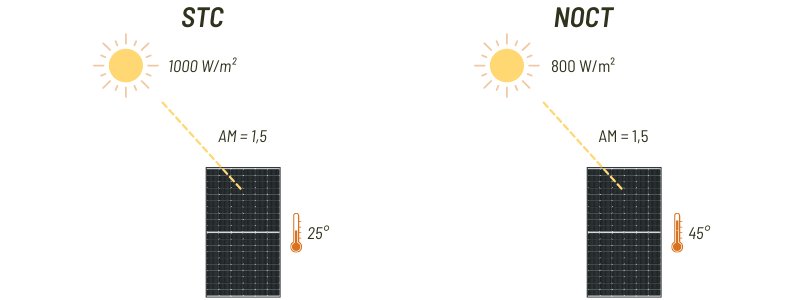STC (Standard Test Conditions) and NOCT (Nominal Operating Cell Temperature) are terms used in the solar industry to define the performance characteristics of photovoltaic (PV) modules. These conditions are important for standardizing the testing and rating of solar panels.
- Standard Test Conditions (STC):
- Definition: STC represents the conditions under which a solar panel is typically tested and rated. These conditions are standardized to provide a basis for comparing the performance of different PV modules.
- STC Conditions:
- Irradiance: 1,000 W/m² (watts per square meter)
- Cell temperature: 25°C (77°F)
- Air mass: 1.5 (AM1.5, indicating the thickness of the Earth’s atmosphere that sunlight passes through)
- Purpose: STC allows manufacturers and consumers to have a common reference point for comparing the power output of different solar panels.
- Nominal Operating Cell Temperature (NOCT):
- Definition: NOCT is a set of conditions that represent the temperature conditions under which a solar panel is expected to operate in the real world.
- NOCT Conditions:
- Irradiance: 800 W/m²
- Ambient temperature: 20°C (68°F)
- Wind speed: 1 m/s
- Purpose: NOCT provides a more realistic estimate of a solar panel’s performance under normal operating conditions, accounting for variations in temperature and other environmental factors.
Key Differences:
- Temperature: The main difference between STC and NOCT is the temperature conditions. STC assumes a cell temperature of 25°C, while NOCT takes into account the actual operating temperature of the solar panel in real-world conditions.
- Irradiance: STC assumes a higher irradiance level (1,000 W/m²) compared to NOCT (800 W/m²). This reflects the fact that solar panels are typically tested under optimal sunlight conditions.
- Purpose: STC is used for standardized testing and rating, providing a baseline for comparing different solar panels. NOCT, on the other hand, is used to estimate the actual operating performance of a solar panel in real-world conditions.
In summary, while STC provides a standardized reference point for comparing solar panels under ideal conditions, NOCT offers a more realistic estimate of a panel’s performance in typical operating conditions.


